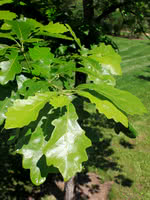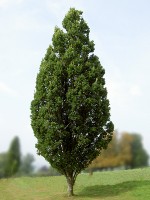Mon-Fri 9am - 5pm Mountain time
Bur Oak vs Cypress Oak
Quercus macrocarpa
Quercus robur Fastigiata
NOT AVAILABLE THIS SEASON - MIGHT RETURN
Bur Oak has a wide distribution but is one of the only oaks that will grow well on the prairies. Bur Oak produces deeply lobed, dark green leaves that turn golden yellow to brown in the fall.
Its acorns are round and half enclosed by a mossy fringed cup.
Although slower growing, this long lived tree eventually becomes a popular large ornamental tree for driveways, parks, and the front of industrial buildings. Popular as a memorial or dedication tree.
Note: Most Oak species can be considered toxic for many animals.
Cypress Oak is an upright, columnar tree that is well suited as a privacy screen or for lining paths and driveways. The upright branch angle causes it to have a narrower spread which makes it suitable for areas with limited space. It has been described as having an elegant, formal look, growing into an upright oval shape with a short trunk. Compared to other oaks it has a much faster growth rate, especially when young.
Cypress Oak is an ancient oak species of England. Traditionally druids respect the oldest oak trees, considering them to be oracles.
Note: Most Oak species can be considered toxic for many animals.

